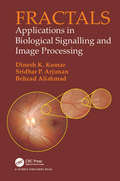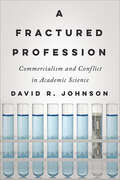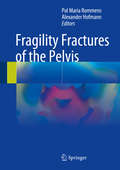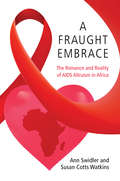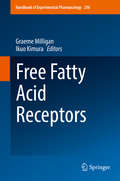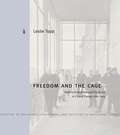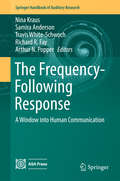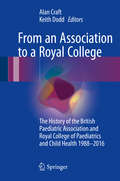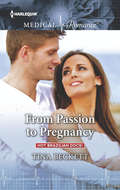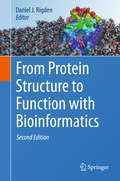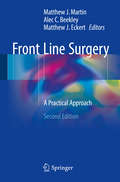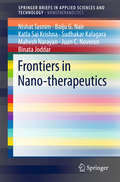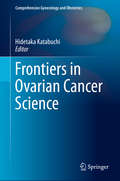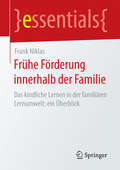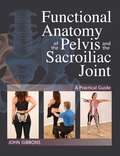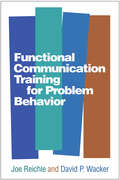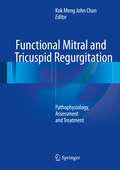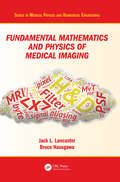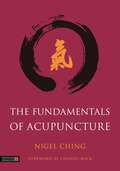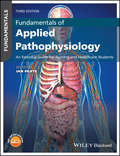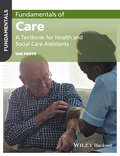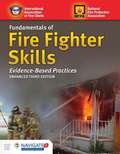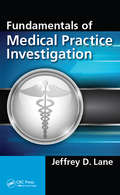- Table View
- List View
Fractals: Applications in Biological Signalling and Image Processing
by Dinesh Kumar Sridhar P. Arjunan Behzad AliahmadThe book provides an insight into the advantages and limitations of the use of fractals in biomedical data. It begins with a brief introduction to the concept of fractals and other associated measures and describes applications for biomedical signals and images. Properties of biological data in relations to fractals and entropy, and the association with health and ageing are also covered. The book provides a detailed description of new techniques on physiological signals and images based on the fractal and chaos theory. The aim of this book is to serve as a comprehensive guide for researchers and readers interested in biomedical signal and image processing and feature extraction for disease risk analyses and rehabilitation applications. While it provides the mathematical rigor for those readers interested in such details, it also describes the topic intuitively such that it is suitable for audience who are interested in applying the methods to healthcare and clinical applications. The book is the outcome of years of research by the authors and is comprehensive and includes other reported outcomes.
A Fractured Profession: Commercialism and Conflict in Academic Science (Critical University Studies)
by David R. JohnsonExploring the growing division among academic scientists over a profit motive in research.The commercialization of research is one of the most significant contemporary features of US higher education, yet we know surprisingly little about how scientists perceive and experience commercial rewards. A Fractured Profession is the first book to systematically examine the implications of commercialization for both universities and faculty members from the perspective of academic scientists. Drawing on richly detailed interviews with sixty-one scientists at four universities across the United States, sociologist David R. Johnson explores how an ideology of commercialism produces intraprofessional conflict in academia.The words of scientists themselves reveal competing constructions of status, conflicting norms, and divergent career paths and professional identities. Commercialist scientists embrace a professional ideology that emphasizes the creation of technologies that control societal uncertainties and advancing knowledge toward particular—and financial—ends. Traditionalist scientists, on the other hand, often find themselves embattled and threatened by university and federal emphasis on commercialization. They are less concerned about issues such as conflicts of interest and corruption than they are about unequal rewards, unequal conditions of work, and conflicts of commitment to university roles and basic science.Arguing that the division between commercialists and traditionalists represents a new form of inequality in the academic profession, this book offers an incisive look into the changing conditions of work in an era of academic capitalism. Focusing on how the profit motive is reshaping higher education and redefining what faculty are supposed to do, this book will appeal to scientists and academics, higher education scholars, university administrators and policy makers, and students considering a career in science.
Fragility Fractures of the Pelvis
by Pol Maria Rommens Alexander HofmannThanks to an increasing life expectancy of our populations the number of elderly persons is steadily growing and will continue to do so. Among these, the rate of persons with illnesses and degenerative diseases is significant. The prevalence of osteoporosis is especially high in elderly women and leads to typical fracture patterns. Hip fractures, proximal humerus fractures, distal radius fractures and fractures of the vertebral column are the most common. In the last decade, we are confronted with a sharp increase of fragility fractures of the pelvis. Until now, there is no consensus on how to identify and classify these lesions and there are no guidelines for treatment and after treatment. In particular, there is no common view on which patients need an operative treatment and which technique of osteosynthesis should be used. This book fills the gap in available literature and gives a state of the art guide to the treatment of fragility fractures of the pelvis. With the sharp increase of these fractures and the lacking consensus, Fragility Fractures of the Pelvis will become indispensable for the physicians who take care of elderly patients with this pathology. Written by a team of expert opinion leaders, the aim of this book is to contribute to the scientific discussion in this area and to help provide the optimal care for these patients.
A Fraught Embrace: The Romance and Reality of AIDS Altruism in Africa (Princeton Studies in Cultural Sociology #72)
by Ann Swidler Susan Cotts WatkinsIn the wake of the AIDS pandemic, legions of organizations and compassionate individuals descended on Africa from faraway places to offer their help and save lives. A Fraught Embrace shows how the dreams of these altruists became entangled with complex institutional and human relationships. Ann Swidler and Susan Cotts Watkins vividly describe the often mismatched expectations and fantasies of those who seek to help, of the villagers who desperately seek help, and of the brokers on whom both Western altruists and impoverished villagers must rely.Based on years of fieldwork in the heavily AIDS-affected country of Malawi, this powerful book digs into the sprawling AIDS enterprise and unravels the paradoxes of AIDS policy and practice. All who want to do good—from idealistic volunteers to world-weary development professionals—depend on brokers as guides, fixers, and cultural translators. These irreplaceable but frequently unseen local middlemen are the human connection between altruists' dreams and the realities of global philanthropy. The mutual misunderstandings among donors, brokers, and villagers—each with their own desires and moral imaginations—create all the drama of a romance: longing, exhilaration, disappointment, heartache, and sometimes an enduring connection. Personal stories, public scandals, and intersecting, sometimes clashing fantasies bring the lofty intentions of AIDS altruism firmly down to earth. Swidler and Watkins ultimately argue that altruists could accomplish more good, not by seeking to transform African lives but by helping Africans achieve their own goals. A Fraught Embrace unveils the tangled relations of those involved in the collective struggle to contain an epidemic.
Free Fatty Acid Receptors
by Graeme Milligan Ikuo KimuraThis book highlights the important role free fatty acids (FFA) play as potential drug targets. While FFA have long been considered byproducts of cell metabolism, they are now recognized as ligands that regulate cell and tissue function via G-protein-coupled receptors. At least three receptors have been identified for which FFA appear to be the endogenous ligands.
Freedom and the Cage: Modern Architecture and Psychiatry in Central Europe, 1890–1914 (Buildings, Landscapes, and Societies #10)
by Leslie ToppSpurred by ideals of individual liberty that took hold in the Western world in the late nineteenth century, psychiatrists and public officials sought to reinvent asylums as large-scale, totally designed institutions that offered a level of freedom and normality impossible in the outside world. This volume explores the “caged freedom” that this new psychiatric ethos represented by analyzing seven such buildings established in the Austro-Hungarian monarchy between the late 1890s and World War I.In the last two decades of the Habsburg Empire, architects of asylums began to abandon traditional corridor-based plans in favor of looser formations of connected villas, echoing through design the urban- and freedom-oriented impulse of the progressive architecture of the time. Leslie Topp considers the paradoxical position of designs that promoted an illusion of freedom even as they exercised careful social and spatial control over patients. In addition to discussing the physical and social aspects of these institutions, Topp shows how the commissioned buildings were symptomatic of larger cultural changes and of the modern asylum’s straining against its ideological anchorage in a premodern past of “unenlightened” restraint on human liberty.Working at the intersection of the history of architecture and the history of psychiatry, Freedom and the Cage broadens our understanding of the complexity and fluidity of modern architecture’s engagement with the state, with social and medical projects, and with mental health, psychiatry, and psychology.
Freedom and the Cage: Modern Architecture and Psychiatry in Central Europe, 1890–1914 (Buildings, Landscapes, and Societies #10)
by Leslie ToppSpurred by ideals of individual liberty that took hold in the Western world in the late nineteenth century, psychiatrists and public officials sought to reinvent asylums as large-scale, totally designed institutions that offered a level of freedom and normality impossible in the outside world. This volume explores the “caged freedom” that this new psychiatric ethos represented by analyzing seven such buildings established in the Austro-Hungarian monarchy between the late 1890s and World War I.In the last two decades of the Habsburg Empire, architects of asylums began to abandon traditional corridor-based plans in favor of looser formations of connected villas, echoing through design the urban- and freedom-oriented impulse of the progressive architecture of the time. Leslie Topp considers the paradoxical position of designs that promoted an illusion of freedom even as they exercised careful social and spatial control over patients. In addition to discussing the physical and social aspects of these institutions, Topp shows how the commissioned buildings were symptomatic of larger cultural changes and of the modern asylum’s straining against its ideological anchorage in a premodern past of “unenlightened” restraint on human liberty.Working at the intersection of the history of architecture and the history of psychiatry, Freedom and the Cage broadens our understanding of the complexity and fluidity of modern architecture’s engagement with the state, with social and medical projects, and with mental health, psychiatry, and psychology.
Freedom from Constipation: Natural Remedies for Digestive Health
by Christopher VaseyA practical guide to discovering the cause of your constipation and finding the right natural remedy for your unique case • Details the 8 main causes of constipation and how to determine which is at the root of your difficulties • Offers practical advice on how to correct each type of constipation with natural and non-aggressive methods, such as dietary changes, herbs, and relaxation methods • Explains gentle, natural ways to empty the bowels when quick relief is necessary • Reveals how treating constipation properly can restore full function not only to the digestive system but to the liver and kidneys as well Constipation has many causes. Most people do not know the exact cause of their constipation and thus have trouble finding lasting relief. Yet there are many natural remedies available that can be tailored to your body’s specific needs. In this step-by-step guide, Christopher Vasey explains how healthy intestines work and the different forms that constipation can take. He details the 8 main causes of constipation: lack of roughage, lack of water, liver dysfunction, constipating foods or medications, weak muscles, imbalances in intestinal flora, stress and anxiety, and nutritional deficiencies. He helps you discover which of the 8 causes underlies your unique case and offers practical advice on how to correct it with natural and non-aggressive methods, such as dietary changes, herbs, and relaxation techniques. For situations when quick relief is necessary, he provides gentle ways to empty the bowels, including natural laxatives and enemas, explaining which to choose for each type of constipation, but also stressing that these are only temporary solutions. Explaining how constipation can be a symptom of a deeper imbalance, the author explores how treating it properly can restore full function not only to the digestive system but to the liver and kidneys as well. In this practical guide, you will learn how to support the work of your intestines, allowing your body to gradually resume its natural working rhythm.
The Frequency-Following Response
by Nina Kraus Samira Anderson Travis White-Schwoch Richard R. Fay Arthur N. PopperThis volume will cover a variety of topics, including child language development; hearing loss; listening in noise; statistical learning; poverty; auditory processing disorder; cochlear neuropathy; attention; and aging. It will appeal broadly to auditory scientists--and in fact, any scientist interested in the biology of human communication and learning. The range of the book highlights the interdisciplinary series of questions that are pursued using the auditory frequency-following response and will accordingly attract a wide and diverse readership, while remaining a lasting resource for the field.
From an Association to a Royal College
by Alan Craft Keith DoddThis book describes the history of the Royal College of Paediatrics and Child Health (RCPCH) covering the period from 1988 to 2014, which includes the transition from the British Paediatric Association (BPA) to the formation of the now established RCPCH. The book contains a collection of viewpoints from paediatricians who held officer posts with the association and College through this time. The authors offer insights and reflections to help the reader understand where the College is at the moment on a variety of core paediatric issues, and significantly where it has come from. The formation of the RCPCH from the BPA was very controversial, with some members resigning from the RCP. Since then, the College has come a long way and is now recognised as the definitive body to speak for children's health in the UK and has forged relationships with many overseas countries. It has produced influential documents, and lobbied for advances in the practice of paediatrics. It has reported on standards for how children should be cared for in emergency and urgent care settings, launched policy to improve how children are looked after in the secure estate, and produced teaching and training materials for child protection among many other contributions to child health. Finally, it will be of interest to other Colleges and professional bodies as well as to Members and Fellows of the College.
From Passion to Pregnancy
by Tina BeckettAfter just one night... The last thing Dr. Sebastian Texeira wants is to settle down, but when one sizzling night with sexy nurse Sara Moreira results in pregnancy, he feels he must do the right thing! Sara refuses to marry for anything less than love. Though she does agree to work at Sebastian's hospital-where the temperature between them grows hotter than ever! All Sebastian needs to secure their happiness is to admit how much he really loves Sara, but sometimes the simplest things are the hardest to do...
From Protein Structure to Function with Bioinformatics
by Daniel J. RigdenThis book is about protein structural bioinformatics and how it can help understand and predict protein function. It covers structure-based methods that can assign and explain protein function based on overall folds, characteristics of protein surfaces, occurrence of small 3D motifs, protein-protein interactions and on dynamic properties. Such methods help extract maximum value from new experimental structures, but can often be applied to protein models. The book also, therefore, provides comprehensive coverage of methods for predicting or inferring protein structure, covering all structural classes from globular proteins and their membrane-resident counterparts to amyloid structures and intrinsically disordered proteins. The book is split into two broad sections, the first covering methods to generate or infer protein structure, the second dealing with structure-based function annotation. Each chapter is written by world experts in the field. The first section covers methods ranging from traditional homology modelling and fold recognition to fragment-based ab initio methods, and includes a chapter, new for the second edition, on structure prediction using evolutionary covariance. Membrane proteins and intrinsically disordered proteins are each assigned chapters, while two new chapters deal with amyloid structures and means to predict modes of protein-protein interaction. The second section includes chapters covering functional diversity within protein folds and means to assign function based on surface properties and recurring motifs. Further chapters cover the key roles of protein dynamics in protein function and use of automated servers for function inference. The book concludes with two chapters covering case studies of structure prediction, based respectively on crystal structures and protein models, providing numerous examples of real-world usage of the methods mentioned previously. This book is targeted at postgraduate students and academic researchers. It is most obviously of interest to protein bioinformaticians and structural biologists, but should also serve as a guide to biologists more broadly by highlighting the insights that structural bioinformatics can provide into proteins of their interest.
Front Line Surgery
by Matthew J. Martin Alec C. Beekley Matthew J. EckertThe second edition of Front Line Surgery expands upon the success of the first edition, providing updated discussion of practical management of commonly encountered combat injuries. This edition reflects the cutting edge of combat casualty care, refined principles of surgical management of specific injury patterns, and incorporation of the spectrum of recent research advancements in trauma care. Each chapter continues to follow the same organization as the first edition. The "BLUF", or bottom line up front, headlines each topic, providing the critical pearls for the reader, followed by a focused and straight forward discussion of management, pitfalls, and recommendations. In addition, select chapters conclude with a section discussing the application of this topic in civilian practice, as potentially encountered by the rural or humanitarian relief surgeon. Additional new topics include: REBOA and endovascular techniques for hemorrhage control, updates in transfusion and resuscitation practice, active shooter situations, rural trauma management in developed nations, advancements in prehospital care and the Tactical Combat Casualty Care (TC3) course, and discussion of the newest generations of topical hemostatic agents and tourniquets. These additions serve to both enhance the breadth and depth of the material relevant to military surgeons, but should also further expand the applicability and interest in this work to all civilian trauma surgeons.
Frontiers in Nano-therapeutics
by Nishat Tasnim Baiju G. Nair Katla Sai Krishna Sudhakar Kalagara Mahesh Narayan Juan C. Noveron Binata JoddarThis brief highlights recent research advances in the area of nano-therapeutics. Nanotechnology holds immense potential for application in a wide range of biological and engineering applications such as molecular sensors for disease diagnosis, therapeutic agents for the treatment of diseases, a vehicle for delivering therapeutics and imaging agents for theranostic applications, both in-vitro and in-vivo. The brief is grouped into the following sections namely, A) Discrete Nanosystems ; B) Anisotropic Nanoparticles; C) Nano-films/coated/layered and D) Nano-composites.
Frontiers in Ovarian Cancer Science
by Hidetaka KatabuchiThis volume presents the latest advances and the current status of our understanding regarding ovarian cancer, addressing both the basic and clinical aspects of the disease. In terms of basic medicine, the WHO Classification of Tumors of Female Reproductive Organs was revised in 2014, and that version addresses several new concepts and histopathological classifications not previously included. One of the most revolutionary breakthroughs concerns the genesis of epithelial ovarian tumors, shifting the focus from the ovarian surface epithelium to serous tubal intraepithelial carcinomas. Clinically, the mortality rate of epithelial ovarian cancer has gradually increased over the past few decades, making it essential to pursue multidisciplinary treatment and apply novel techniques such as neoadjuvant chemotherapy in daily clinical practice. The primary clinical task is the effective treatment of recurrent ovarian cancer with early palliative medicine. Fertility-sparing surgery may also be pursued depending on histologic subtypes, stage, extent of disease, and preexisting ovarian reserve with the concept of oncofertility. On the basis of the considerations described above, each expert author elucidates the science of ovarian cancer in detail, thus providing a collection that will benefit young medical oncologists and seasoned gynecologists and obstetricians alike.
Frühe Förderung innerhalb der Familie: Das kindliche Lernen in der familiären Lernumwelt: ein Überblick (essentials)
by Frank NiklasFrank Niklas setzt sich in diesem essential mit dem spannenden Themenfeld der familiären Lernumwelt auseinander. Der Autor fasst alles Wichtige zur Förderung früher mathematischer und schriftsprachlicher Kompetenzen innerhalb der Familie einfach und kompakt zusammen. So zeigt er, dass Würfelspiele und Vorlesen bereits ein guter Start, aber bei Weitem noch nicht alles sind. Eine anregungsreiche und positive familiäre Lernumwelt für die eigenen Kinder zu gestalten, gelingt nicht einfach so nebenbei. Aber es ist auch nicht allzu schwierig, die eigenen Kinder zu unterstützen – und viel wichtiger: Es kann richtig Spaß machen.
Functional Anatomy of the Pelvis and the Sacroiliac Joint: A Practical Guide
by John GibbonsThis step-by-step guide for assessing the pelvis and sacroiliac joint by respected bodywork specialist John Gibbons explores all aspects of this crucial area of the body and how it links within the kinetic chain system. Gibbons--a registered sports osteopath who specializes in the treatment and rehabilitation of sport-related injuries—provides detailed information about how to recognize pain and dysfunctional patterns that arise from the pelvic girdle along with techniques to identify and correct a number of impaired patterns as well as functional exercises that promote recovery. Fully illustrated with 350 color photos, this book will give practitioners, students, and anyone who wants to understand pelvic pain and what they can do about it a wealth of practical information. Gibbons addresses key issues such as the walking/gait cycle and its relationship to the pelvis; leg length discrepancy and its relationship to the kinetic chain and the pelvis; the laws of spinal mechanics, the relationship of the hip joint, gluteal muscles, and lumbar spine to the pelvis; and sacroiliac joint screening. He discusses role of the Glutes, Psoas, Rectus femoris and other muscles and what happens to the position of the pelvis if these soft tissues become shortened. Detailed exercises and techniques are carefully illustrated with photographs that explain each movement, and an appendix for quick reference adds to the usefulness of the text.
Functional Communication Training for Problem Behavior
by David P. Wacker Joe ReichleChildren and adolescents with moderate and severe disabilities often have communication challenges that lead them to use problem behavior to convey their desires. This is the most comprehensive contemporary volume on functional communication training (FCT)--the individualized instructional approach that teaches a child socially acceptable communicative alternatives to aggression, tantrums, self-injury, and other unconventional behaviors. The expert authors provide accessible, empirically based guidelines for implementing FCT, and tips for overcoming obstacles. Grounded in the principles of applied behavior analysis, the book includes detailed strategies for developing a support plan, together with illustrative case examples.
Functional Mitral and Tricuspid Regurgitation
by Kok Meng John ChanThis book covers in detail all aspects of functional mitral and tricuspid regurgitation, from its pathophysiology and natural history, to its assessment, medical and surgical treatment, and long term results. Functional Mitral and Tricuspid Regurgitation encompasses information and knowledge from a diverse background including cardiology, cardiac surgery and basic science. This is necessary for a full understanding of the subject in order to optimally manage patients with this condition.
Fundamental Mathematics and Physics of Medical Imaging (Series in Medical Physics and Biomedical Engineering)
by Jack Lancaster Bruce HasegawaAuthored by a leading educator, this book teaches the fundamental mathematics and physics concepts associated with medical imaging systems. Going beyond mere description of imaging modalities, this book delves into the mechanisms of image formation and image quality common to all imaging systems: contrast mechanisms, noise, and spatial and temporal resolution, making it an important reference for medical physicists and biomedical engineering students. This is an extensively revised new edition of The Physics of Medical X-Ray Imaging by Bruce Hasegawa (Medical Physics Publishing, 1991), and includes a wide range of modalities such as X-ray CT, MRI and SPECT.
The Fundamentals of Acupuncture
by Charles Buck Nigel ChingThis accessible textbook clearly explains the basic foundations and principles of acupuncture and Chinese Medicine. With over 70 illustrations, it covers the theories of yin and yang, the five phases, the physiology of the body, the internal organs, the channel system, acupuncture point categories, the point functions and indications, needling techniques and aetiological factors. Authoritative, yet readable, this is a vital addition to the shelves of all students of Chinese medicine.
Fundamentals of Applied Pathophysiology: An Essential Guide for Nursing and Healthcare Students
by Ian PeateFundamentals of Applied Pathophysiology continues to be an accessible and comprehensive introductory text to pathophysiology, written specifically for nursing and healthcare students to assist in the understanding of human anatomy, and the complex disease patterns that affect normal physiology. Thoroughly updated, and with full-colour illustrations throughout, this new edition incorporates additional learning features including reflective questions at the end of each chapter, investigation boxes, medication alerts, red flags to indicate essential information to be aware of when providing care, vital signs boxes relating to physiological measurements as well as inclusion of the National Early Warning Score. With emphasis placed on a multidisciplinary approach, Fundamentals of Applied Pathophysiology highlights the importance of contemporary, safe, and effective practice in an environment in which the delivery of care is constantly evolving.
Fundamentals of Care: A Textbook for Health and Social Care Assistants
by Ian PeateFundamentals of Care is an accessible introductory textbook for all health care assistants; assistant practitioners and social care support workers who are undertaking the newly introduced, mandatory Care Certificate, as well as offering a resource for providing care and support. Practically focused, each chapter begins with the outcomes associated with each standard, which helps contextualise and focus the reader on the content and relevance to the Care Certificate. The book also includes exercises to encourage the reader to stop, look, listen and act, thinking cap activity promotes further thinking and application to care and support provision along with case studies and resource files. Written to help the reader come to terms with the role and function of the heath and care assistants, Fundamentals of Care offers support to those undertaking the Care Certificate and to assist those who already work as health and care assistants, helping them in their quest to enhance safe and effective care.
Fundamentals Of Fire Fighter Skills: Evidence-based Practices
by National Fire Protection AssociationEach new print copy of Fundamentals of Fire Fighter Skills also includes Navigate 2 Advantage Access that unlocks a complete eBook, Study Center, homework and Assessment Center, and a dashboard that reports actionable data. Experience Navigate 2 today at www.jblnavigate.com/2. The National Fire Protection Association (NFPA) and the International Association of Fire Chiefs (IAFC) are pleased to bring you the third edition of Fundamentals of Fire Fighter Skills, the next step in the evolution of Fire Fighter I and Fire Fighter II training. With superior teaching and learning tools, the first and second editions of Fundamentals of Fire Fighter Skills set a new benchmark in fire fighter training. Now the NFPA, IAFC, and Jones & Bartlett Learning are proud to raise the bar for the fire service again. Comprehensive Content The third edition covers the entire spectrum of the 2013 Edition of NFPA 1001: Standard for Fire Fighter Professional Qualifications, as well as the requirements for Operations level responders in the 2013 Edition of NFPA 472: Standard for Competence of Responders to Hazardous Materials/Weapons of Mass Destruction Incidents. From fire suppression to hazardous materials to emergency medical care, this one volume covers all of Fire Fighter I and Fire Fighter II training requirements. The training program also includes coverage of the UL/NIST research studies and experiments on fire behavior and techniques for ventilation, fire suppression, and search and rescue as a result of the changes in modern building construction and furnishing materials. As a result of these changes, today's fires release energy faster, reach flashover potential sooner, may reach higher temperatures, and are much more likely to become ventilation-limited than building fires of even a few years ago. Tools for Success * Quickly identify Fire Fighter II content and skill drills through clear visual roadmaps. * Rapidly access content through clear and concise Knowledge and Skill Objectives with page references, as well as NFPA 1001 and 472 correlations. * Encourage critical thinking skills. Fire Fighter I and Fire Fighter II case studies offer students a genuine context for applying the knowledge presented in the chapter.
Fundamentals of Medical Practice Investigation
by Jeffrey D. LaneFundamentals of Medical Practice Investigation fills an important gap in the resources for criminal investigators. Appropriate for novice medical investigators as well as seasoned investigators looking to sharpen their skills, this book unites step-by-step fundamentals with up-to-date research reviews of critical issues in the field, including sexual misconduct, patient abuse, drug use among medical practitioners, and unethical or illegal prescription practices. An essential tool for law enforcement and other criminal justice professionals, Fundamentals of Medical Practice Investigation will improve the quality of all types of medical investigation.
